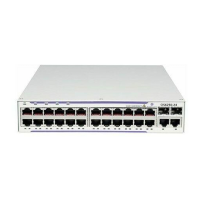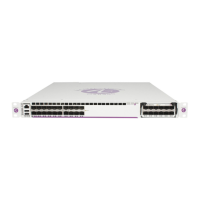Network QoS Policies
7210 SAS D, E, K OS Quality of Service Guide Page 139
Resource Allocation for Network QoS policy on 7210 SAS-D and
7210 SAS-E
This section describes the allocation of QoS resources for network QoS policies. When the port
mode is changed to access-uplink, a default network QoS policy is applied. For the default policy,
two meters and eighteen classification entries in hardware are allocated.
For every FC in use, the system allocates two classification entries in hardware, if the FC is
configured to use both the unicast meter and the multicast meter or if the default meter 9 is
configured in the policy. If multiple match criteria entries map to the same FC, then each of these
are allocated two classification entries in hardware. For example, if there are two match-criteria
entries that map to FC ‘af’, then a total of four classification entries are allocated in hardware and
if there are four match-criteria entries that map to FC ‘af’, then a total of 8 classification entries are
allocated in hardware.
For every meter or policer in use, the system allocates one meter in hardware. A meter or policer is
considered to be in use when it is associated with an FC in use.
For computing the number of QoS resources used by an access uplink port:
• Determine number of match-criteria entries used to identify the FC.
• Determine number of FCs to use.
Only the FCs used by the match-criteria classification entries are to be considered for the 'number
of FCs'. Therefore are referred to as ‘FC in use’. Also, note that in network policy of type 'ip-
interface' default multipoint meter 9 is created in a policy, whereas, for policy of type 'port' default
multipoint meter needs to be explicitly configured by the user, if required.
Use the following rules to compute the number of classification entries per FC in use:
If a FC is in use and is created without explicit meters, use default meter#1 for unicast traffic and
default meter #9 (if configured) for all other traffic types (that is, broadcast, multicast and
unknown-unicast). This requires two classification entries in hardware. If default multipoint meter
9 is not configured, then the FC will use the unicast meter for all traffic types. In this case, the FC
requires a single classification entry in hardware.
If a FC is in use and is created with an explicit unicast meter, use that meter for unicast traffic and
use default meter #9 (if configured) for all other traffic types. This requires two classification
entries in hardware. If default multipoint meter 9 is not configured, then the FC will use the unicast
meter for all traffic types. In this case, the FC requires a single classification entry in hardware.
If a FC is in use and is created with an explicit unicast meter and explicit multicast meter, use the
unicast meter for unicast traffic and multicast meter for all other kinds of traffic. This requires two
classification entries in hardware.

